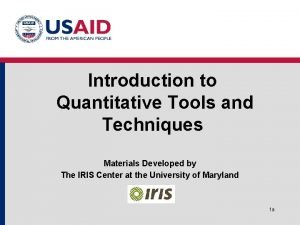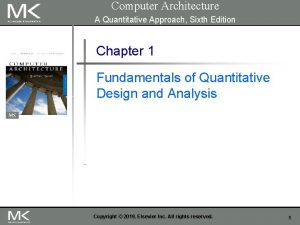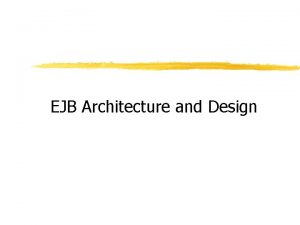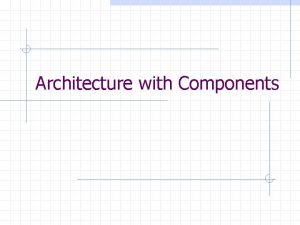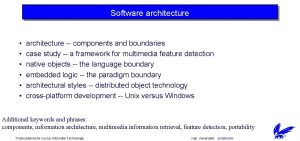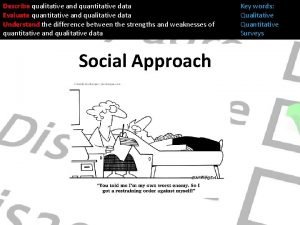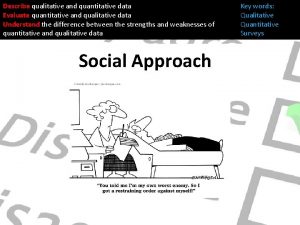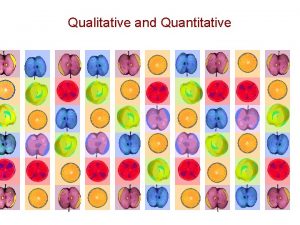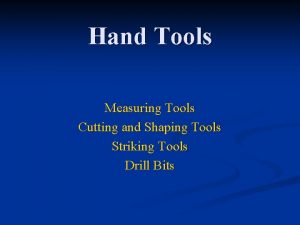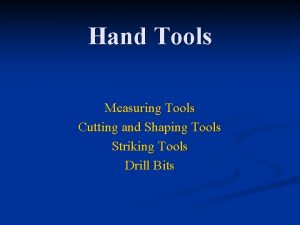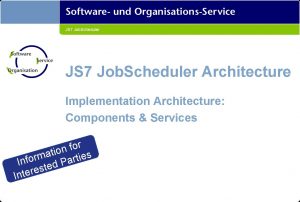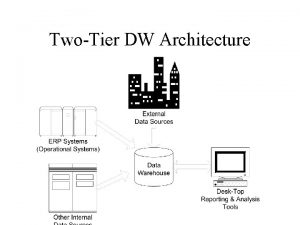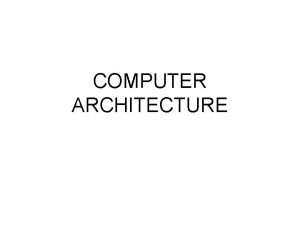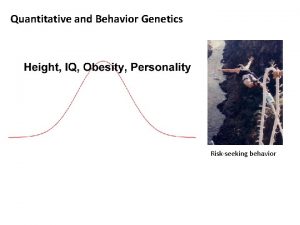EMERGING ARCHITECTURE OF TOOLS AND COMPONENTS FOR QUANTITATIVE





























































- Slides: 61

EMERGING ARCHITECTURE OF TOOLS AND COMPONENTS FOR QUANTITATIVE MODELING AND DECISION SUPPORT Presented To: “Landelijk Netwerk Mathematische Besliskunde” (LNMB) and the “Nederlands Genootschap voor Besliskunde” (NGB) 16 January 2003 Gautam Mitra CARISMA Department of Mathematical Sciences, Brunel University and Opti. Ris. K Systems

EMERGING ARCHITECTURE OF TOOLS AND COMPONENTS FOR QUANTITATIVE MODELING AND DECISION SUPPORT Supported by researchers and colleagues including: E F D Ellison, C A Lucas, N Jobst, P Valente, N S Koutsoukis, C Poojari, B Dominguez-Ballesteros, T Kyriakis, A Mirhassani, G Birbilis Acknowledgement UK Research Council: EPSRC and UK Govt Industrial sponsors include: Fidelity Investments, APT Inc. , UBS Warburg, Unilever Research, EU sponsored: OSP CRAFT , SCHUMANN project (Daimler Chrysler, Ford Spain, Yamanouchi BV, Iberinco, LCP)

Outline 1. Introduction and Background 2. A historical /skills perspective 3. An information systems perspective 4. Mix and Match Models 5. Illustrative Applications 6. DSS and IS Connections 7. A Web perspective 8. Discussions

1. Introduction and Background MPG to CARISMA Knowledge Systems Solution Systems Computational Optimisation Linear Programming Sparse Simplex Modelling LP Modelling Integer Programming Interior Point Method Constraint Satisfaction IP Models Preprocessing Branch & Bound Polyhedral CP Parallel platforms Stochastic Programming Algebraic LP Language Risk Decisions Information Systems

1. Introduction and Background Convergent activities/developments • • CARISMA The Centre for the Analysis of Risk and CARISMA Optimisation Modelling Applications SPIn. E: Stochastic Programing Integrated Environment BOOK: Interaction of information systems and decision technologies. by Nikitas S Koutsoukis and Gautam Mitra, Kluwer. OSP-CRAFT and WEBOPT: Optimisation Services provision over the net

1. Introduction and Background Mission of CARISMA The mission of CARISMA is to be a centre of excellence recognised for its research and scholarship in the following: · · · the analysis of risk, optimisation modelling, the combined paradigm of risk and return quantification. Industry Focus Finance Industry - Bank, Insurance, Pension Funds Large Corporates - FTSE 100, Multinationals, EUROTOP Public Sector/Utilities, Environment, Food, Agriculture, Health

1. Introduction and Background The Faculty Director: Professor Gautam Mitra Deputy Director: Professor Christos Ioannidis Research Lecturers: Paresh Date, Fabio Spagnolo, Chandra Poojari Newly approved open positions : Research professor in Risk Modelling and Research Lecturer in Financial Risk Faculty members: 7 professors and 5 lecturers Research Associates : 4 Ph. D. Students: 16

Outline 1. Introduction and Background 2. A historical /skills perspective 3. An information systems perspective 4. Mix and Match Models 5. Illustrative Applications 6. DSS and IS Connections 7. A Web perspective 8. Discussions

2. A historical /skills perspective

2. A historical /skills perspective Constituents and their interaction

2. A historical /skills perspective l Skills Requirement – – Algorithm design and tuning Software engineering and testing Information engineering Domain expertise n n n Financial engineering Logistics and supply chain Transportation planning and scheduling – Project development (solutions/applications) n n Proof of concept quick win deployment (System integrators)

Outline 1. Introduction and Background 2. A historical /skills perspective 3. An information systems perspective 4. Mix and Match Models 5. Illustrative Applications 6. DSS and IS Connections 7. A Web perspective 8. Discussions

3. An information systems perspective Information and Decision Technologies Business Intelligence: Competitive Advantage Middleware Decision Modelling Data Mining, KDD Middleware Analytic Database Production Database

Information & Knowledge: The Value Chain EIS, OLAP Production Database Data Analysis & Synthesis Analytic Database Information Application of Models Knowledge 14

Data sources Data preparation Data collection software External data ERP systems Other transaction systems Data storage Data mart Legacy databases KNOWLEDGE WORKERS Summarization Cleanse Pattern recognition Impute Exception detection Transform Segmentation Calculate Data warehouse Enrich Deployment INFORMATION CONSUMERS Desktop software Description Extract Classification Profiling Scoring Browser Web Server Browser Forecasting Manage Simulation Load Functional department systems Data analysis & data mining Browser Optimization Data mart MODEL BUILDERS Paper Reports

OLAP and Multidimensional Viewing: Main features l Multidimensionality = Data


Outline 1. Introduction and Background 2. A historical /skills perspective 3. An information systems perspective 4. Mix and Match Models 5. Illustrative Applications 6. DSS and IS Connections 7. A Web perspective 8. Discussions

Modelling SP Modelling distribution of random variables Optimum Allocation Modelling STOCHASTIC PROGRAMMING MODELLING - Scenario Analysis Expected Value Two Stage RP Multistage RP Chance Constrained Problems Others

Event tree l l Historical data 1978 – 1996 1 year horizon divided in 4 quarters

Scenario Generation

Extended Syntax for AMLs l l Consider SP models as refinement of deterministic problems by introduction of uncertainty SP models identify: – An underlying deterministic model (core) – Information related to the randomness of the model (stochastic framework)

SP Modelling Constructs

Scenario Generation and SP Modelling

ALM model in SPIn. E: solution

Value at Risk l Finance industry has introduced Value at Risk (VAR) also known as the β-var. -fractile return r(x, y)

Va. R Computation

Va. R Results Implemented Solution Va. R HN 131638 EV 82565

Outline 1. Introduction and Background 2. A historical /skills perspective 3. An information systems perspective 4. Mix and Match Models 5. Illustrative Applications 6. DSS and IS Connections 7. A Web perspective 8. Discussions

l Supply Chain Application

Stochastic Programming Supply Chain Model 1 Production (PR) Packing (PC) Distribution Centres (DC) Customer Zones (CZ)

Stochastic Programming Supply Chain Model 2

Stochastic Programming l Stochastic Programming with recourse models are ideally suited. . two perspectives – (near) optimum resource allocation – hedge against uncertain future outcomes – Decisions not optimum for any one outcome, good for many outcomes ! l Two stage models – First Stage: ‘ Here-and-Now’ asset allocation decisions … takes into consideration scenarios(outcomes) – Second Stage: Recourse decisions optimal corrective actions as future unfolds…

Stochastic Programming Model and data instances Scenarios: 100

Stochastic Programming

l Portfolio Application

Uncertainty… optimum decisions Modelling approach l l Construct decision models which capture return and risk (due to uncertainty) Combine models of optimum resource allocation and models of randomness

Information Systems…Data marts Transactional Database Information Analysis Models Analytical Database Decision Database Data Mart Portfolio Models

Information Systems…Datamarts Information Analysis Models Pre-analysis Performance Indicators Style Analysis Financial Ratios CAPM APT Simulation Models Internal Company Models Model Data Parameters Solution Analysis Historical data Weighted Moving Average Factor Models Time Series Models ARCH, GARCH, … Neural Networks Genetic Algorithms Kalman Filters Chaos Internal Company Models What if Analysis Scenario Analysis Simulation Backtesting Internal Company Models Post-analysis Performance Indicators Risk Statistics and Indices Financial Ratios CAPM APT Simulation Models Risk Metrics Internal Company Models

Information Systems…Data marts Production Database Market Data: Historical Prices Internal Data: Portfolios, Cashflows. . . Analytical Models Data Mart Pre-Analytical Database Model Data Parameters: Average Return Var/Cov Matrix. . . Pre Analytics: Styles, Risk Statistics, Financial Ratios. . . Decision Database Optimisation Results: Portfolio Returns, Potfolio Risk, Optimum Asset Mix Post-Analytical Database Analytical Models Results Analytics: What if, Different objectives. . . Post Analytics: Backtesting, Risk Analysis. . . Optimisation Engine User Input: Risk Aversion, Target Portfolio Return. . Portfolio Optimisation Model Continuous or Discrete Modelling System Solver

l Model/Results Explanation

Supply Chain Cost ($) C Efficient Frontier B B 1 A Customer Service measured in maximal delivery time (days) B 2 1 2 3 4

Financial Risks l Markowitz (Nobel Prize) – Mean variance (M-V Theory) – Diversification through ‘not strongly correlated assets’

Outline 1. Introduction and Background 2. A historical /skills perspective 3. An information systems perspective 4. Mix and Match Models 5. Illustrative Applications 6. DSS and IS Connections 7. A Web perspective 8. Discussions


Portfolio Holdings data Aknowledgment to Alpha Strategies

Absolute Volatilities & Correlations Aknowledgment to Alpha Strategies

The Algebra of Risk Decomposition l l l We begin by breaking down the total variance of a portfolio into contributions from individual holdings We have From which we derive individual contributions to variance as Aknowledgment to Alpha Strategies

Contributions from Groups of Holdings l We can generalise these expressions from individual holdings to groups of holdings as follows : - Aknowledgment to Alpha Strategies

Marginal Contributions to Risk Aknowledgment to Alpha Strategies

Summary of Absolute Decomposition Aknowledgment to Alpha Strategies

Outline 1. Introduction and Background 2. A historical /skills perspective 3. An information systems perspective 4. Mix and Match Models 5. Illustrative Applications 6. DSS and IS Connections 7. A Web perspective 8. Discussions

Traditional Optimisationbased DSS Traditionally, optimisation applications comprise models, the optimiser, and a data mart, connected via a model management system. Models Typical Optimisation Decision Support System End-User Application Modelling System Data Mart Computation Algorithms: Solutions

A typical Optimisation Solution Training Consultancy R&D Models End-User Application Modelling System Data Mart End-User Interaction with System Computation: Algorithmic Solutions

Access to Tools End User Groups End User Modelling Systems Internet, WAN, Other NET Computation Tools Models Data Mart Technology

Access to Vertical Solutions/DSS Models End User Groups End-User Application Internet, WAN, Other NET Data Mart End User Modelling System Computation: Algorithmic Solutions DSS 1 Models End-User Application Modelling System Data Mart Computation: Algorithmic Solutions DSS 2

Outline 1. Introduction and Background 2. A historical /skills perspective 3. An information systems perspective 4. Mix and Match Models 5. Illustrative Applications 6. DSS and IS Connections 7. A Web perspective 8. Discussions

Discussion 1 l OR software tools and components are developed to – Respond to business needs – Incorporate current technology platforms Different skill sets are required to bring together technology solutions New developments in Risk modelling and risk management bring simulationa nd optimisation closer Role of Model explanation Web is ‘the’ preferred / chosen delivery platform

Discussion 2

Discussion 2

for your attention …any questions ? I would appreciate your feedback…comments Thank You www. carisma. brunel. ac. uk www. optirisk-systems. com
 Tools of quantitative techniques
Tools of quantitative techniques Computer architecture 5th edition
Computer architecture 5th edition Computer architecture a quantitative approach
Computer architecture a quantitative approach Computer architecture a quantitative approach sixth edition
Computer architecture a quantitative approach sixth edition Computer architecture a quantitative approach
Computer architecture a quantitative approach Computer architecture a quantitative approach sixth edition
Computer architecture a quantitative approach sixth edition Computer architecture a quantitative approach sixth edition
Computer architecture a quantitative approach sixth edition Ejb architecture
Ejb architecture Ecommerce system architecture
Ecommerce system architecture Fspos
Fspos Typiska drag för en novell
Typiska drag för en novell Tack för att ni lyssnade bild
Tack för att ni lyssnade bild Returpilarna
Returpilarna Varför kallas perioden 1918-1939 för mellankrigstiden?
Varför kallas perioden 1918-1939 för mellankrigstiden? En lathund för arbete med kontinuitetshantering
En lathund för arbete med kontinuitetshantering Kassaregister ideell förening
Kassaregister ideell förening Tidbok
Tidbok A gastrica
A gastrica Densitet vatten
Densitet vatten Datorkunskap för nybörjare
Datorkunskap för nybörjare Tack för att ni lyssnade bild
Tack för att ni lyssnade bild Att skriva en debattartikel
Att skriva en debattartikel Magnetsjukhus
Magnetsjukhus Nyckelkompetenser för livslångt lärande
Nyckelkompetenser för livslångt lärande Påbyggnader för flakfordon
Påbyggnader för flakfordon Lufttryck formel
Lufttryck formel Offentlig förvaltning
Offentlig förvaltning Lyckans minut erik lindorm analys
Lyckans minut erik lindorm analys Presentera för publik crossboss
Presentera för publik crossboss Vad är ett minoritetsspråk
Vad är ett minoritetsspråk Kanaans land
Kanaans land Treserva lathund
Treserva lathund Luftstrupen för medicinare
Luftstrupen för medicinare Bästa kameran för astrofoto
Bästa kameran för astrofoto Centrum för kunskap och säkerhet
Centrum för kunskap och säkerhet Byggprocessen steg för steg
Byggprocessen steg för steg Mat för idrottare
Mat för idrottare Verktyg för automatisering av utbetalningar
Verktyg för automatisering av utbetalningar Rutin för avvikelsehantering
Rutin för avvikelsehantering Smärtskolan kunskap för livet
Smärtskolan kunskap för livet Ministerstyre för och nackdelar
Ministerstyre för och nackdelar Tack för att ni har lyssnat
Tack för att ni har lyssnat Referatmarkeringar
Referatmarkeringar Redogör för vad psykologi är
Redogör för vad psykologi är Stål för stötfångarsystem
Stål för stötfångarsystem Atmosfr
Atmosfr Borra hål för knoppar
Borra hål för knoppar Orubbliga rättigheter
Orubbliga rättigheter Formel gruplar
Formel gruplar Tack för att ni har lyssnat
Tack för att ni har lyssnat Rita perspektiv
Rita perspektiv Vad är verksamhetsanalys
Vad är verksamhetsanalys Tobinskatten för och nackdelar
Tobinskatten för och nackdelar Toppslätskivling effekt
Toppslätskivling effekt Handledning reflektionsmodellen
Handledning reflektionsmodellen Egg för emanuel
Egg för emanuel Elektronik för barn
Elektronik för barn Antika plagg
Antika plagg Strategi för svensk viltförvaltning
Strategi för svensk viltförvaltning Var 1721 för stormaktssverige
Var 1721 för stormaktssverige Ellika andolf
Ellika andolf Romarriket tidslinje
Romarriket tidslinje
